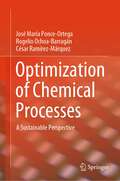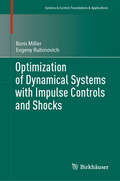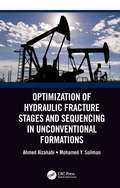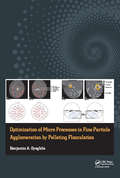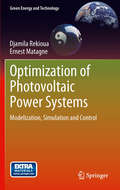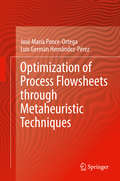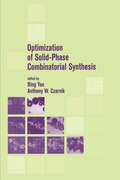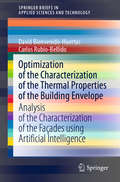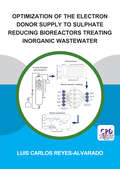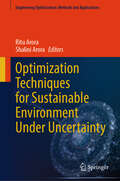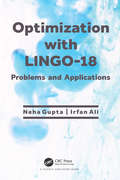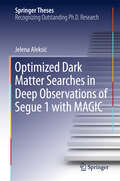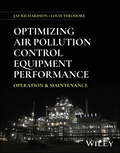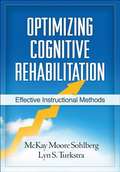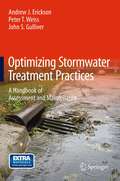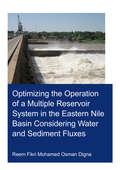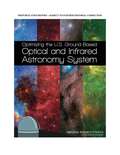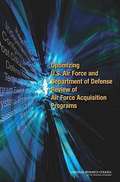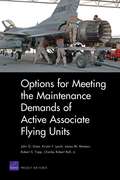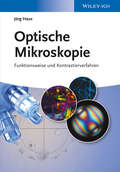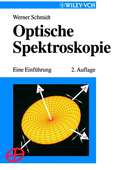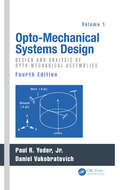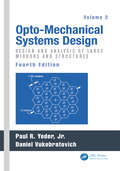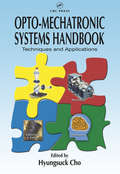- Table View
- List View
Optimization of Chemical Processes: A Sustainable Perspective
by José María Ponce-Ortega Rogelio Ochoa-Barragán César Ramírez-MárquezThis textbook introduces readers to a comprehensive framework for the application of deterministic optimization strategies in the field of chemical processes, with a strong emphasis on sustainability.The book establishes a vital connection between fundamental deterministic optimization principles, optimization tools, and real-world application instances, all within the context of environmentally responsible practices. The approach put forth in this book is exceptionally versatile, allowing for the use of many optimization software and deterministic techniques.Contained in the book are many fundamental optimization concepts, encompassing linear programming, nonlinear programming, integer programming, and multi-objective optimization, all tailored to promote sustainable decision-making. Furthermore, the book provides practical examples illustrating the application of these techniques within sustainable chemical processes as tutorials.The textbook also explores the utilization of popular optimization software platforms such as GAMS, MATLAB, and Python, demonstrating how these tools can be leveraged for eco-friendly process optimization. Through this comprehensive framework, readers can not only acquire the skills needed to optimize a wide range of processes but also learn how to do so with sustainability at the forefront of their considerations. This approach streamlines the optimization process, eliminating unnecessary complications along the way and ensuring that environmental and ethical considerations are integral to the decision-making process.
Optimization of Dynamical Systems with Impulse Controls and Shocks (Systems & Control: Foundations & Applications)
by Boris Miller Evgeny RubinovichThis text explores the state-of-the-art in the rapidly developing theory of impulse control and introduces the theory of singular space-time transformations, a new method for studying shock mechanical systems. Two approaches in the theory of impulse control are presented: The first, more traditional approach defines the impulsive action as a discontinuity of phase coordinates depending on the current time, the state preceding the action, and its magnitude. The second requires the use of modern methods for describing dynamical systems - differential equations with measures. The impulse is treated as an idealization of a very short action of high magnitude, which produces an almost abrupt change of phase coordinates. The relation between these two approaches is also discussed, and several applications, both traditional and emerging, are considered. This text is intended for graduate students and researchers in control engineering and optimal control theory for dynamical systems. Readers are assumed to be familiar with the theory of ODEs, optimal control, and functional analysis, though an appendix is included that covers many of the necessary mathematical concepts.
Optimization of Energy Supply Systems: Modelling, Programming and Analysis (Lecture Notes in Energy #69)
by Janet NagelThis book describes how a model for optimizing the energy supply system in Germany can be implemented. It focuses on the open energy modeling framework (Oemof) program for modeling energy supply systems. The individual elements of Oemof are described, as well as the model’s structure. The technical components of Oemof are subsequently demonstrated in mathematical calculations, along with sufficient Python code to begin basic modeling. The book will appeal to anyone with an interest in optimization models for energy supply systems, or in the mathematical description of the technical components of such systems in practical implementation, using a real example, Oemof. Thermodynamic descriptions of combustion are provided, so that readers can focus on modeling aspects. Researchers and practitioners will also find the book useful, as it expands on their knowledge of the technical components of energy supply systems, supported with detailed mathematical calculations.
Optimization of Hydraulic Fracture Stages and Sequencing in Unconventional Formations
by Ahmed Alzahabi Mohamed Y. SolimanShale gas and/or oil play identification is subject to many screening processes for characteristics such as porosity, permeability, and brittleness. Evaluating shale gas and/or oil reservoirs and identifying potential sweet spots (portions of the reservoir rock that have high-quality kerogen content and brittle rock) requires taking into consideration multiple rock, reservoir, and geological parameters that govern production. The early determination of sweet spots for well site selection and fracturing in shale reservoirs is a challenge for many operators. With this limitation in mind, Optimization of Hydraulic Fracture Stages and Sequencing in Unconventional Formations develops an approach to improve the industry’s ability to evaluate shale gas and oil plays and is structured to lead the reader from general shale oil and gas characteristics to detailed sweet-spot classifications. The approach uses a new candidate selection and evaluation algorithm and screening criteria based on key geomechanical, petrophysical, and geochemical parameters and indices to obtain results consistent with existing shale plays and gain insights on the best development strategies going forward. The work introduces new criteria that accurately guide the development process in unconventional reservoirs in addition to reducing uncertainty and cost.
Optimization of Micro Processes in Fine Particle Agglomeration by Pelleting Flocculation
by Benjamin OyegbileEfficient particle separation in order to meet stringent regulatory standards represent one of the biggest challenges facing the process industry operators today. Emerging environmental problems such as climate change, population growth and natural resource depletion make it more compelling to undertake research into alternative phase separation techniques and optimization of existing ones. Meeting this challenge requires innovative, revolutionary and integrated approach in the design and optimization of various unit processes in fine particle separation. Flocculation is widely used as an effective phase separation technique across many process industries such as water and wastewater treatment and in minerals processing. In this work, a new pre-treatment technique was developed using a patented bench scale reactor unit as a technical proof of concept. Furthermore, the book provides a valuable insight into the hydrodynamics and fluid-particle interactions within the agglomeration units. The relatively high solids content of the stable pellets (approximately 30 %) and very low residual turbidity of the post-sedimentation supernatant (7 NTU) clearly demonstrate the potential of this technique. In addition to significantly improving the subsequent solid-liquid separation efficiency, this study also showed that the effluent can be recycled back into the sewer network or utilized for non-portable reuse. The findings obtained from this research will be extremely useful in the scaling up and optimization of the reactor system.
Optimization of Photovoltaic Power Systems
by Djamila Rekioua Ernest MatagnePhotovoltaic generation is one of the cleanest forms of energy conversion available. One of the advantages offered by solar energy is its potential to provide sustainable electricity in areas not served by the conventional power grid. Optimisation of Photovoltaic Power Systems details explicit modelling, control and optimisation of the most popular stand-alone applications such as pumping, power supply, and desalination. Each section is concluded by an example using the MATLAB® and Simulink® packages to help the reader understand and evaluate the performance of different photovoltaic systems. Optimisation of Photovoltaic Power Systems provides engineers, graduate and postgraduate students with the means to understand, assess and develop their own photovoltaic systems. As such, it is an essential tool for all those wishing to specialise in stand-alone photovoltaic systems. Optimisation of Photovoltaic Power Systems aims to enable all researchers in the field of electrical engineering to thoroughly understand the concepts of photovoltaic systems; find solutions to their problems; and choose the appropriate mathematical model for optimising photovoltaic energy.
Optimization of Process Flowsheets through Metaheuristic Techniques
by Luis Germán Hernández-Pérez José María Ponce-OrtegaThis textbook presents a general multi-objective optimization framework for optimizing chemical processes by implementing a link between process simulators and metaheuristic techniques. The proposed approach is general and shows how to implement links between different process simulators such as Aspen Plus®, HYSIS®, Super Pro Designer® linked to a variety of metaheuristic techniques implemented in Matlab®, Excel®, C++, and others, eliminating the numerical complications through the optimization process. Furthermore, the proposed framework allows the use of thermodynamic, design and constitutive equations implemented in the process simulator to implement any process. Aimed at graduate and undergraduate students, it presents introductory chapters for process simulators and metaheuristic optimization techniques and provides several worked exercises as well as proposed exercises. In addition, accompanying tutorial videos clearly explaining the implemented methodologies are available online. Also, some Matlab® routines are included as electronic supporting material.
Optimization of Solid-Phase Combinatorial Synthesis
by Bing Yan Anthony W. Czarnik"Addresses the key topic in combinatorial synthesis--how to optimize the quality of a combinatorial library--by determining the usefulness of synthesized compunds, the reliability of biological assay results, and analyzing acadmic and industrial applications, real-world examples, and case studies of successful and unsuccessful technologies."
Optimization of the Characterization of the Thermal Properties of the Building Envelope: Analysis of the Characterization of the Façades using Artificial Intelligence (SpringerBriefs in Applied Sciences and Technology)
by David Bienvenido-Huertas Carlos Rubio-BellidoThis book is about the optimization of the characterization of the thermal properties of building envelopes, through experimental tests and the use of artificial intelligence. It analyses periodic and stationary thermal properties using measurement approaches based on the heat flow meter method and the thermometric method. These measurements are then analysed using advanced artificial intelligence algorithms.The book is structured in four parts, beginning with a discussion of the importance of thermal properties in the energy performance of buildings. Secondly, theoretical and experimental methods for characterizing thermal properties are analysed. Then, the methodology is developed, and the characteristics and properties of the algorithms used are explored. Finally, the results obtained with the algorithms are analysed and the most appropriate approaches are determined.This book is of interest to researchers, civil and industrial engineers, energy auditors and architects, by providing a resource which improves energy audit tasks in existing buildings.
Optimization of the Electron Donor Supply to Sulphate Reducing Bioreactors Treating Inorganic Wastewater (IHE Delft PhD Thesis Series)
by Luis Carlos Reyes-AlvaradoThe main objective of this research was to optimize the electron donor supply in sulphate reducing bioreactors treating sulphate rich wastewater. Two types of electron donor were tested: lactate and slow release electron donors such as carbohydrate based polymers and lignocellulosic biowastes. Biological sulphate reduction was evaluated in different bioreactor configurations: the inverse fluidized bed, sequencing batch and batch reactors. The reactors were tested under steady-state, high-rate and transient-state feeding conditions of electron donor and acceptor, respectively. The results showed that the inverse fluidized bed reactor configuration is robust and resilient to transient and high-rate feeding conditions at a hydraulic retention time as low as 0.125 d. The biological sulphate reduction was limited by the COD:sulphate ratio ( 82% either using carbohydrate based polymers or lignocellulosic bio-wastes, in batch bioreactors. The biological sulphate reduction was limited by the hydrolysis-fermentation rate and by the complexity of the slow release electron donors.
Optimization Techniques for Sustainable Environment Under Uncertainty (Engineering Optimization: Methods and Applications)
by Ritu Arora Shalini AroraThe book's objective is to develop mathematical structures that can be applied to real-life problems with sustainable goals. It focuses on the impact of sustainable living on social, economic, and environmental aspects, aiming to create optimization techniques that minimize emissions and maximize green energy. These optimization problems may include sustainable transport, cities, economic development, living, and tourism. The book brings together researchers, academics, and professionals from various fields to find optimal or satisfactory solutions for various environmentally friendly sustainable problems. It aims to achieve this not only with existing optimization techniques, but also with novel approaches such as lexicographic optimization, heuristic approaches, DEA, and genetic algorithms. The goal is to develop practical algorithms and methods applicable to these problems under uncertain circumstances and explore the potential for improving the efficiency of existing algorithms.
Optimization with LINGO-18: Problems and Applications
by Irfan Ali Neha GuptaThis book presents fundamental concepts of optimization problems and its real-world applications in various fields. The core concepts of optimization, formulations and solution procedures of various real-world problems are provided in an easy-to-read manner. The unique feature of this book is that it presents unified knowledge of the modelling of real-world decision-making problems and provides the solution procedure using the appropriate optimization techniques. The book will help students, researchers, and faculty members to understand the need for optimization techniques for obtaining optimal solution for the decision-making problems. It provides a sound knowledge of modelling of real-world problems using optimization techniques. It is a valuable compendium of several optimization techniques for solving real-world application problems using optimization software LINGO. The book is useful for academicians, practitioners, students and researchers in the field of OR. It is written in simple language with a detailed explanation of the core concepts of optimization techniques. Readers of this book will understand the formulation of real-world problems and their solution procedures obtained using the appropriate optimization techniques.
Optimized Dark Matter Searches in Deep Observations of Segue 1 with MAGIC
by Jelena AleksićThis thesis presents the results of indirect dark matter searches in the gamma-ray sky of the near Universe, as seen by the MAGIC Telescopes. The author has proposed and led the 160 hours long observations of the dwarf spheroidal galaxy Segue 1, which is the deepest survey of any such object by any Cherenkov telescope so far. Furthermore, she developed and completely characterized a new method, dubbed "Full Likelihood", that optimizes the sensitivity of Cherenkov instruments for detection of gamma-ray signals of dark matter origin. Compared to the standard analysis techniques, this novel approach introduces a sensitivity improvement of a factor of two (i. e. it requires 4 times less observation time to achieve the same result). In addition, it allows a straightforward merger of results from different targets and/or detectors. By selecting the optimal observational target and combining its very deep exposure with the Full Likelihood analysis of the acquired data, the author has improved the existing MAGIC bounds to the dark matter properties by more than one order of magnitude. Furthermore, for particles more massive than a few hundred GeV, those are the strongest constraints from dwarf galaxies achieved by any gamma-ray instrument, both ground-based or space-borne alike.
Optimizing Air Pollution Control Equipment Performance: Operation and Maintenance
by Jay Richardson Louis TheodoreComprehensive overview of the air pollution control technology field including the design, selection, operation, and maintenance of relevant devices Optimizing Air Pollution Control Equipment Performance delivers an analysis of the subject of air pollution control equipment from the perspective of the practicing engineer or an applied scientist, rather than a theoretical perspective. Written by a team of highly qualified authors with experience in both industry and academia, coverage includes: Design and selection of a variety of relevant devices as well as carbon dioxide capture processes and technologies related to control of NOx Strategies to ensure that air pollution control systems meet stringent emission standards and latest technological requirements, with up-to-date references throughout Typical problems related to air pollution control equipment, emphasizing where and how these factors can have a major impact on the maintenance problems of control devices Methods to reduce maintenance costs and prevent deterioration of collector performance A timely reference detailing problems that have plagued users for nearly 100 years, Optimizing Air Pollution Control Equipment Performance earns a well-deserved spot on the bookshelves of professionals working in environmental control, including consultants, engineers, and government agency personnel, as well as advanced students in related programs of study.
Optimizing Cognitive Rehabilitation
by Lyn Turkstra Mckay SohlbergRehabilitation professionals face a key challenge when working with clients with acquired cognitive impairments: how to teach new skills to individuals who have difficulty learning. Unique in its focus, this book presents evidence-based instructional methods specifically designed to help this population learn more efficiently. The expert authors show how to develop, implement, and evaluate an individualized training plan. They provide practical guidelines for teaching multistep procedures, cognitive strategies, the use of external aids, and more. User-friendly features include 17 sample worksheets and forms; blank forms can be downloaded and printed in a convenient 8 1/2" x 11" size.
Optimizing Stormwater Treatment Practices
by Andrew J. Erickson John S Gulliver Peter T WeissOptimizing Stormwater Treatment Practices: A Handbook of Assessment and Maintenance provides the information necessary for developing and operating an effective maintenance program for stormwater treatment. The book offers instructions on how to measure the level of performance of stormwater treatment practices directly and bases proposed maintenance schedules on actual performance and historical maintenance efforts and costs. The inspection methods, which are proven in the field and have been implemented successfully, are necessary as regulatory agencies are demanding evaluations of the performance of stormwater treatment practices. The authors have developed a three-tiered approach that offers readers a standard protocol for how to determine the effectiveness of stormwater treatment practices currently in place.
Optimizing the Operation of a Multiple Reservoir System in the Eastern Nile Basin Considering Water and Sediment Fluxes (IHE Delft PhD Thesis Series)
by Reem Fikri DignaThe Eastern Nile riparian countries Egypt, Ethiopia and Sudan are currently developing several reservoir projects to contribute to the needs for energy and food production in the region. The Nile Basin, particularly the Eastern Nile Sub-basin, is considered one of a few international river systems with potential conflicts between riparian countries. In the absence of formal mechanisms for collaboration, the transboundary nature of this basin makes sound water resources development challenging. The large seasonal and inter-annual variability of the river flow exacerbates those challenges. A further complication is the high sediment load in the Eastern Nile rivers during the high flow season. This study contributes to fill relevant knowledge gaps through a better understanding of the methods needed for a complex system of multipurpose reservoirs, considering both water quantity and sediment load. The study quantifies the impacts of water resources development in the Eastern Nile basin and identifies system management options at both regional and country level. Developing a collaborative and unified perspective of the countries towards new projects can be beneficial for all. New operation rules are proposed for improving operation of the current system when new infrastructures are developed and operated either unilaterally or, ideally, cooperatively.
Optimizing the U.S. Ground-Based Optical and Infrared Astronomy System
by Committee on a Strategy to Optimize the U.S. Optical Infrared System in the Era of the Large Synoptic Survey TelescopeNew astronomical facilities, such as the under-construction Large Synoptic Survey Telescope and planned 30-meter-class telescopes, and new instrumentation on existing optical and infrared (OIR) telescopes, hold the promise of groundbreaking research and discovery. How can we extract the best science from these and other astronomical facilities in an era of potentially flat federal budgets for both the facilities and the research grants? "Optimizing the U. S. Ground-Based Optical and Infrared Astronomy System" provides guidance for these new programs that align with the scientific priorities and the conclusions and recommendations of two National Research Council (NRC) decadal surveys, "New Worlds, New Horizons for Astronomy and Astrophysics" and "Vision and Voyages for Planetary Sciences in the Decade 2013-2022," as well as other NRC reports. This report describes a vision for a U. S. OIR System that includes a telescope time exchange designed to enhance science return by broadening access to capabilities for a diverse community, an ongoing planning process to identify and construct next generation capabilities to realize decadal science priorities, and near-term critical coordination, planning, and instrumentation needed to usher in the era of LSST and giant telescopes.
Optimizing U.S. Air Force and Department of Defense Review of Air Force Acquisition Programs
by National Research Council of the National AcademiesThe Department of Defense (DOD) spends over $300 billion each year to develop, produce, field and sustain weapons systems (the U.S. Air Force over $100 billion per year). DOD and Air Force acquisitions programs often experience large cost overruns and schedule delays leading to a loss in confidence in the defense acquisition system and the people who work in it. Part of the DOD and Air Force response to these problems has been to increase the number of program and technical reviews that acquisition programs must undergo. This book looks specifically at the reviews that U.S. Air Force acquisition programs are required to undergo and poses a key question: Can changes in the number, content, or sequence of reviews help Air Force program managers more successfully execute their programs? This book concludes that, unless they do it better than they are now, Air Force and DOD attempts to address poor acquisition program performance with additional reviews will fail. This book makes five recommendations that together form a gold standard for conduct of reviews and if implemented and rigorously managed by Air Force and DOD acquisition executives can increase review effectiveness and efficiency. The bottom line is to help program managers successfully execute their programs.
Options for Meeting the Maintenance Demands of Active Associate Flying Units
by Robert S. Tripp James M. Masters Kristin F. Lynch John G. Drew Charles Robert RollRAND developed a methodology to help understand and explain the differences between U.S. Air National Guard and active component aircraft maintenance productivity. This research focuses on maintenance options for supporting associate units, where the goal of the associate unit is to produce trained pilots in the most efficient manner possible.
Optische Mikroskopie: Funktionsweise und Kontrastierverfahren
by Jörg HausIn diesem Buch werden die wichtigsten Aspekte der Technik des Lichtmikroskops erklärt wie auch weitergehende und moderne mikroskopische Verfahren. <P><P>Der Text ist leicht verständlich geschrieben mit praktischen Anwendungsbeispielen und vielen mikroskopischen Aufnahmen.
Optische Spektroskopie: Eine Einführung
by Werner SchmidtThis book is a compact and simultaneously comprehensive introduction to the theory and practice of optical spectroscopy. The author skillfully leads the reader from the basics to practical applications. The main topics covered are: - theory of optical spectroscopy - components of spectrometers (light sources, filters, lenses and mirror chromators, detectors, cuvettes) - evaluation of data and interpretation of spectra Such important methods as absorption and luminescence spectroscopy, scattering and reflection spectroscopy and photoaccustic spectroscopy are covered in depth. A useful appendix with the addresses of pertinent equipment manufacturers rounds off the work. Easy to understand and well illustrated, this book is suitable both as a textbook for beginners and as a reference work for the practitioner.
Opto-Mechanical Systems Design, Volume 1: Design and Analysis of Opto-Mechanical Assemblies (Optical Science And Engineering Ser.)
by Paul Yoder and Daniel VukobratovichOpto-Mechanical Systems Design, Fourth Edition is different in many ways from its three earlier editions: coauthor Daniel Vukobratovich has brought his broad expertise in materials, opto-mechanical design, analysis of optical instruments, large mirrors, and structures to bear throughout the book; Jan Nijenhuis has contributed a comprehensive new chapter on kinematics and applications of flexures; and several other experts in special aspects of opto-mechanics have contributed portions of other chapters. An expanded feature—a total of 110 worked-out design examples—has been added to several chapters to show how the theory, equations, and analytical methods can be applied by the reader. Finally, the extended text, new illustrations, new tables of data, and new references have warranted publication of this work in the form of two separate but closely entwined volumes. This first volume, Design and Analysis of Opto-Mechanical Assemblies, addresses topics pertaining primarily to optics smaller than 50 cm aperture. It summarizes the opto-mechanical design process, considers pertinent environmental influences, lists and updates key parameters for materials, illustrates numerous ways for mounting individual and multiple lenses, shows typical ways to design and mount windows and similar components, details designs for many types of prisms and techniques for mounting them, suggests designs and mounting techniques for small mirrors, explains the benefits of kinematic design and uses of flexures, describes how to analyze various types of opto-mechanical interfaces, demonstrates how the strength of glass can be determined and how to estimate stress generated in optics, and explains how changing temperature affects opto-mechanical assemblies.
Opto-Mechanical Systems Design, Volume 2: Design and Analysis of Large Mirrors and Structures (Optical Science And Engineering Ser.)
by Paul Yoder and Daniel VukobratovichOpto-Mechanical Systems Design, Fourth Edition is different in many ways from its three earlier editions: coauthor Daniel Vukobratovich has brought his broad expertise in materials, opto-mechanical design, analysis of optical instruments, large mirrors, and structures to bear throughout the book; Jan Nijenhuis has contributed a comprehensive new chapter on kinematics and applications of flexures; and several other experts in special aspects of opto-mechanics have contributed portions of other chapters. An expanded feature—a total of 110 worked-out design examples—has been added to several chapters to show how the theory, equations, and analytical methods can be applied by the reader. Finally, the extended text, new illustrations, new tables of data, and new references have warranted publication of this work in the form of two separate but closely entwined volumes. This second volume, Design and Analysis of Large Mirrors and Structures, concentrates on the design and mounting of significantly larger optics and their structures, including a new and important topic: detailed consideration of factors affecting large mirror performance. The book details how to design and fabricate very large single-substrate, segmented, and lightweight mirrors; describes mountings for large mirrors with their optical axes in vertical, horizontal, and variable orientations; indicates how metal and composite mirrors differ from ones made of glass; explains key design aspects of optical instrument structural design; and takes a look at an emerging technology—the evolution and applications of silicon and silicon carbide in mirrors and other types of components for optical applications.
Opto-Mechatronic Systems Handbook: Techniques and Applications (Handbook Series for Mechanical Engineering)
by Hyungsuck ChoOpto-mechatronics-the fusion of optical and mechatronic technologies-has been integral in the evolution of machines, systems, and products that are smaller and more precise, more intelligent, and more autonomous. For the technology to reach its full potential, however, engineers and researchers from many disciplines must learn to work together thro
